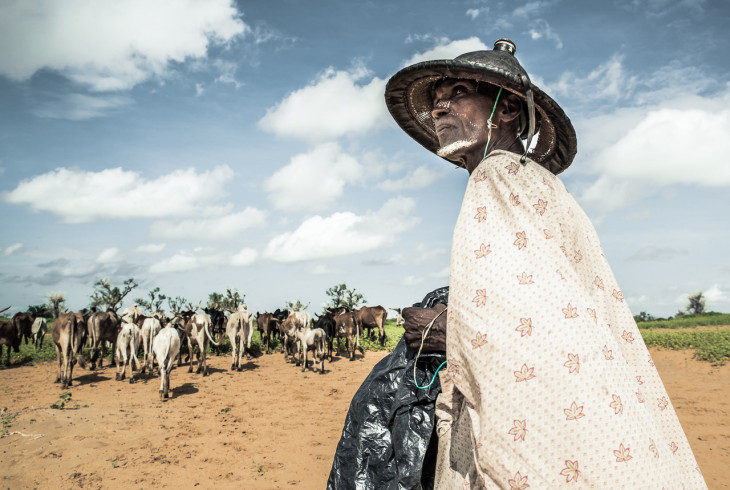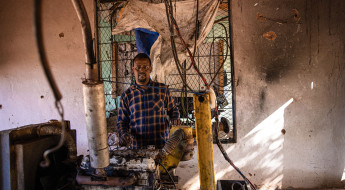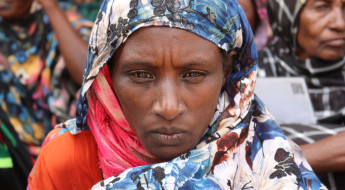Climate change and conflict
Climate is changing everywhere, but it is people living in fragile circumstances who feel the effects most severely. Climate change and conflict continue to cause massive suffering among people by intensifying inequality.

For West Africa, the Intergovernmental Panel on Climate Change forecasts an average increase in temperature of 3.3°C by the year 2100, which could increase to 4.7°C in the northern half of Mali. Samuel TURPIN / Humans & Climate Change Stories
Today's climate and environmental crises affect every aspect of our lives, from our physical and mental health, to our food, water and livelihoods. While these crises affect everyone, those hit hardest are the poorest and most marginalized communities.
People living through conflict frequently tell us about the massive environmental changes they are witnessing. Their daily lives are not only made more difficult by the violence they experience, but also by a changing climate and environment. They are often ill-prepared for repeated climate hazards.
“Like a death sentence for those populations.”
— Al Jazeera English (@AJEnglish) October 25, 2021
Climate change is transforming Mali’s Lake Faguibine into a desert pic.twitter.com/OHrPP5YQt9
In places like Somalia, which has been weakened by decades of conflict and fragility, droughts have repeatedly forced people to move – and so have floods. In the Sahel, an unpredictable climate and environmental degradation make the survival of remote and impoverished communities more difficult each year. Their coping mechanisms are being radically eroded by violence and instability.
A 2023 ICRC/Norwegian Red Cross report Making Adaptation Work presents how the humanitarian consequences of environmental degradation and climate change are aggravated by armed conflict in the Near and Middle East, and which adaptation approaches are emerging to face the compounding impact using examples from Iraq, Syria and Yemen.
In Yemen and Iraq, the water scarcity, which challenges health, food and economic security, is exacerbated by institutional weakness. In many cases, conflict also directly harms the very ecosystems on which people rely to survive.
#ClimateChange is hitting Somalia hard.
— ICRC (@ICRC) October 14, 2021
Here are the numbers pic.twitter.com/YkJ3K5bGhI
People enduring conflict are not only among the most vulnerable to the climate and environmental crises, they are also among those most neglected by climate action, in part because of the challenges attached to working in such surroundings. We are calling for this trend to be reversed.
Humanitarian organizations have an important role to play in addressing these crises. The ICRC works to adapt its response to support populations coping with the dual shocks of climate risks and conflicts.
Together with the IFRC, the ICRC has led the development of a Climate and Environment Charter for Humanitarian Organizations to guide the sector as it responds to these crises and to rally collective action.
The ICRC also strives to become more environmentally responsible. Our activities have repercussions on the environment, and we are committed to minimizing these effects, where possible.
I’ll repeat it again & this time not from the #UNSC but from the middle of the Sahel:
— Patrick Youssef (@PYoussefICRC) October 26, 2022
Armed violence is the main driver of food insecurity & the climate emergency is prolonging existing tensions & perpetuating fragility: Poor harvest, water scarce, intercommunal violence etc pic.twitter.com/8iiAhPAjAe
We need to join forces across the humanitarian sector and beyond to mitigate climate change and ensure that people are adequately supported as they adapt to the climate crisis now and into the future. Inaction is not an option.
Robert Mardini, ICRC Director-General
No one can address these challenges alone. Radical transformation is urgently needed to prevent further suffering. Protecting the lives and rights of present and future generations depends on political action. Reducing greenhouse gas emissions is vital, but these efforts must be complemented by helping communities to adapt.
Despite being among the most vulnerable to the effects of climate change, countries enduring conflict are among the most neglected by climate finance, and in particular, finance for adaptation. This needs to change.
Blazing temperatures.
— ICRC (@ICRC) October 13, 2021
Erratic rainfall.
Dry wells.
Failed crops.
The climate crisis is devastating Burkina Faso. pic.twitter.com/v3S5aeXKCX
In 2020, the ICRC released When Rain turns to Dust. The report illustrates how countries mired in conflict are disproportionately impacted by climate variability and extremes, due to the limited adaptive capacity of people, systems, and institutions already coping with the consequences of conflicts.
It is based on research conducted in southern Iraq, northern Mali and the Central African Republic, all of which face protracted conflict and feature large ICRC operations. The report reflects how the humanitarian sector needs to adjust and adapt to address these risks and calls for climate action and finance to be urgently strengthened in conflict-affected countries.



